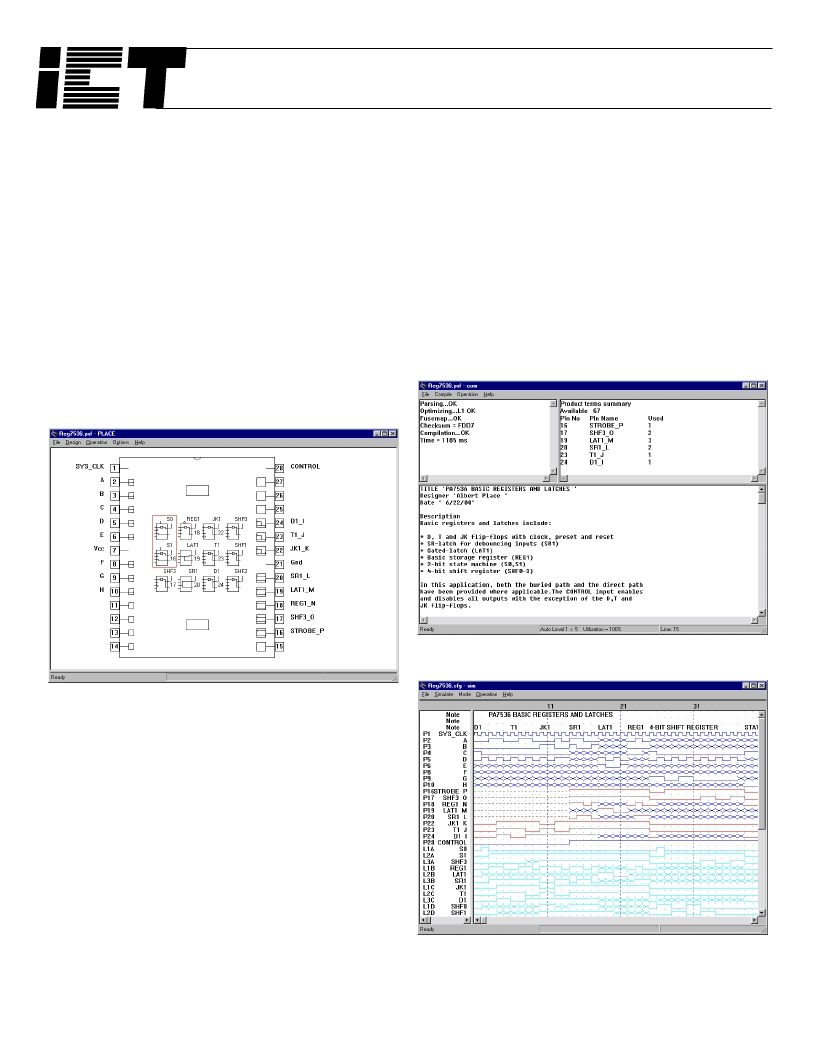- 您現在的位置:買賣IC網 > PDF目錄382370 > PA7536S-15 ASIC PDF資料下載
參數資料
| 型號: | PA7536S-15 |
| 英文描述: | ASIC |
| 中文描述: | 專用集成電路 |
| 文件頁數: | 5/10頁 |
| 文件大小: | 219K |
| 代理商: | PA7536S-15 |

5
04-02-052D
Commercial/Industrial
PEEL
Array Development Support
Development support for PEEL
Arrays is provided by
ICT and manufacturers of popular development tools. ICT
offers the powerful WinPLACE Development Software (free
to qualified PLD designers). The WinPLACE software
includes an architectural editor, logic compiler, waveform
simulator, documentation utility and a programmer
interface. The WinPLACE editor graphically illustrates and
controls the PEEL
Array
’
s architecture, making the
overall design easy to understand, while allowing the
effectiveness of boolean logic equations, state machine
design and truth table entry. The WinPLACE compiler
performs logic transformation and reduction, making it
possible to specify equations in almost any fashion and fit
the most logic possible in every design. WinPLACE also
provides a multi-level logic simulator allowing external and
internal signals to be simulated and analyzed via a
waveform display.(See Figure 12, Figure 13 and Figure 14)
Figure 12 - WinPLACE Architectural Editor for
PA7536
PEEL
Array development is also supported by popular
development tools, such as ABEL and CUPL, via ICT
’
s
PEEL
Array fitters. A special smart translator utility adds
the capability to directly convert JEDEC files for other
devices into equivalent JEDEC files for pin-compatible
PEEL
Arrays.
Programming
PEEL
Arrays are EE-reprogrammable in all package
types, plastic-DIP, PLCC, SOIC and TSSOP. This makes
them an ideal development vehicle for the lab. EE-
reprogrammability is also useful for production, allowing
unexpected changes to be made quickly and without
waste. Programming of PEEL
Arrays is supported by
popular third party programmers.
Design Security and Signature Word
The PEEL
Arrays provide a special EEPROM security bit
that prevents unauthorized reading or copying of designs.
Once set, the programmed bits of the PEEL
Arrays
cannot be accessed until the entire chip has been
electrically
erased.
Another
signature word, allows a user-definable code to be
programmed into the PEEL
Array. The code can be read
back even after the security bit has been set. The signature
word can be used to identify the pattern programmed in the
device or to record the design revision.
programming
feature,
Figure 13 - WinPLACE LCC and IOC screen
Figure 14 - WinPLACE simulator screen
相關PDF資料 |
PDF描述 |
|---|---|
| PA7536SI-15 | ASIC |
| PA7536T-15 | ASIC |
| PA7536TI-15 | ASIC |
| PA7536J-15 | ASIC |
| PA7 | Analog IC |
相關代理商/技術參數 |
參數描述 |
|---|---|
| PA7536S-15L | 功能描述:SPLD - 簡單可編程邏輯器件 14 Input 12 I/O 15ns RoHS:否 制造商:Texas Instruments 邏輯系列:TICPAL22V10Z 大電池數量:10 最大工作頻率:66 MHz 延遲時間:25 ns 工作電源電壓:4.75 V to 5.25 V 電源電流:100 uA 最大工作溫度:+ 75 C 最小工作溫度:0 C 安裝風格:Through Hole 封裝 / 箱體:DIP-24 |
| PA7536SI-15 | 功能描述:SPLD - 簡單可編程邏輯器件 14 INP 12 I/O 15ns RoHS:否 制造商:Texas Instruments 邏輯系列:TICPAL22V10Z 大電池數量:10 最大工作頻率:66 MHz 延遲時間:25 ns 工作電源電壓:4.75 V to 5.25 V 電源電流:100 uA 最大工作溫度:+ 75 C 最小工作溫度:0 C 安裝風格:Through Hole 封裝 / 箱體:DIP-24 |
| PA7536SI-15L | 功能描述:SPLD - 簡單可編程邏輯器件 14 Input 12 I/O 15ns RoHS:否 制造商:Texas Instruments 邏輯系列:TICPAL22V10Z 大電池數量:10 最大工作頻率:66 MHz 延遲時間:25 ns 工作電源電壓:4.75 V to 5.25 V 電源電流:100 uA 最大工作溫度:+ 75 C 最小工作溫度:0 C 安裝風格:Through Hole 封裝 / 箱體:DIP-24 |
| PA7536T-15 | 制造商:未知廠家 制造商全稱:未知廠家 功能描述:ASIC |
| PA7536TI-15 | 制造商:未知廠家 制造商全稱:未知廠家 功能描述:ASIC |
發布緊急采購,3分鐘左右您將得到回復。